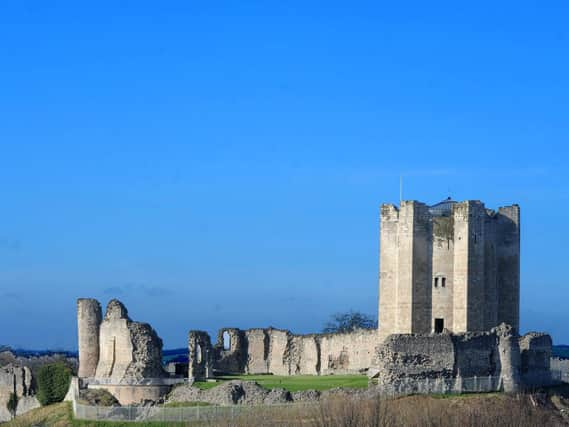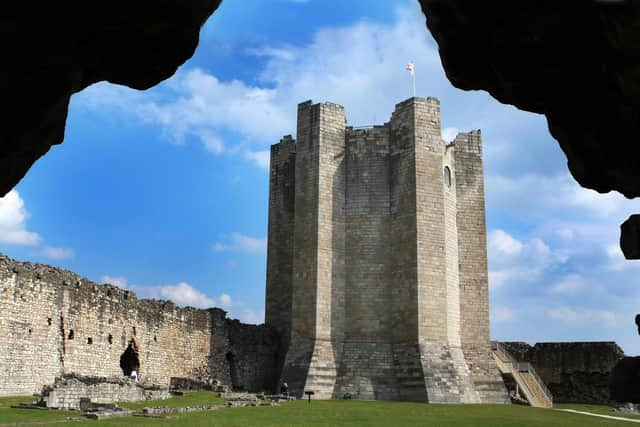Lit up again after 25 years, the story of how Conisbrough Castle became a symbol for a proud community


Last month the castle was illuminated for the first time since the 1990s after Doncaster Council funded a £30,000 LED lighting system which will be maintainted by the Norman castle's owners, English Heritage
The impressive keep - once indicative of military and political power in a strategic location - will be lit up at dusk every day following the culmination of years of lobbying for money to replace the damaged electrics.
Advertisement
Hide AdAdvertisement
Hide AdYet staff do not fear sabotage again this time - for in the past two decades, Conisbrough has gone from a somewhat overlooked visitor attraction situated in a deprived area to a model English Heritage site that is loved by the local community it still seems to watch over, centuries after it was abandoned.


The illumination has become something of a metaphor for the castle's rise again, a decade on from the end of a challenging period of management changes and misguided investments.
A three-way agreement between Doncaster Council, English Heritage and local regeneration charity the Ivanhoe Trust lasted 20 years before it was dissolved in 2008 and the property passed entirely to English Heritage control. Each party had a defined role in the upkeep and running of the site, and it was the council which bankrolled the construction of a controversial visitor centre designed to resemble medieval jousting tournament tents.
European Union funding was secured to restore floors and the roof of the keep, but visitor numbers never rose significantly during this time. In 2013, Heritage Lottery Fund grants enabled more renovations to be completed and the much-maligned tents to be replaced with modern facilities.
Advertisement
Hide AdAdvertisement
Hide AdConisbrough, a former mining town, is at the centre of an area of socio-economic disadvantage between Doncaster and Rotherham, and it has suffered from the closure of local industries. The castle has been a constant source of pride, but now those living nearby are involved and engaged in far greater numbers than ever before, and they champion it tirelessly.
As English Heritage's head of historic properties Simon Bean says, the fortress really is a focal point for the town. In 2016, two local men, Steve Pugh and Russel Asquith, led a campaign for a poppy-themed installation to adorn the castle walls to commemorate the centenary of World War One, so he already had an idea of how well-received the new lighting would be.
"The outpouring of love and affection has been way beyond my expectations."
Marketing the castle has never been easy, despite the fact that it is one of the country's most intact Norman survivors, with an almost storybook appearance - it isn't in an area frequented by tourists, there are no other historic attractions within close proximity and the supporting infrastructure of twee gift shops and tearooms is absent.
Advertisement
Hide AdAdvertisement
Hide AdIt still attracts a respectable 37,000 visitors per year and benefits from South Yorkshire's strong English Heritage membership base, but its management have had to be creative to seek out new audiences.
"As a charity, our aim is to be relevant, and Conisbrough is a perfect place to bring history to life. It's such a fine example of a Norman castle, yet we're not on a main tourist trail and so we've focused instead on engaging younger people with our education programme.
"It does have a bigger audience than is first obvious - we get people from the US sometimes, and it's an easy diversion off the A1 and M1 for people heading to the Dales and Scotland. With the Walter Scott connection too (the writer's novel Ivanhoe was inspired by the castle) there are things to draw visitors in."
Since the team began targeting schools, over 50,000 children living up to an hour's journey from Conisbrough have taken part in hands-on 'discovery' tours, according to education visits officer Matthew Lester.
Advertisement
Hide AdAdvertisement
Hide Ad"We have passionate staff who lead the trips and really immerse them in history in a fun, interactive way. It makes them want to learn more, and on weekends and in the school holidays you get these children coming back with their families. It gives them that ownership and pride in their castle."
Simon adds that the emphasis on education has enabled the site to remain open throughout the year and provide permanent employment.
"It's not quiet in the winter like other places, and it means that volunteers can do more. Our site manager, Gavin Smithies, lives around the corner and is very involved in the community. We allow local groups to hold events in the castle grounds for free.
"Our role is to conserve and preserve these historic buildings, and to keep them accessible. Increasingly, partnerships allow us to develop things and steer the direction we go in. The volunteers and supporters are so passionate about their town, and we want to help attract people to it who will spend money locally."
Advertisement
Hide AdAdvertisement
Hide AdThis mutual commitment means that investment from English Heritage is not restricted to the castle estate. Alongside projects to replace the ageing display projectors inside the keep and install QR codes for visitors to scan using their smartphones to find out more about the building's history, the charity has also pledged to restore and repair a series of footpaths around the mound to make them more attractive to walkers. Re-enactment events will resume after lockdown, and these are promoted primarily in the local area to allow those living nearby to enjoy their castle.
They're also hoping to recruit more volunteers, and both Simon and Matthew have observed changing demographics among their unpaid workforce, with younger people and students joining the more traditional army of retired teachers. Their efforts enable staff to run more activities and guided tours than were previously possible.
Visitor facilities have improved immensely since the removal of the jousting tents, and the centre is now spacious and modern, with space for exhibitions and classroom learning.
As Simon concludes: "We couldn't have lit up the castle without being in partnership with others. It was a slow process, after the last set of lights were vandalised we needed to convince people we were spending public money properly, but actually we don't suffer much anti-social behaviour at Conisbrough. I think that's because the local kids are involved with their castle - and it's become a benchmark for other English Heritage sites."
A history of Conisbrough Castle
Advertisement
Hide AdAdvertisement
Hide Ad- Conisbrough was an important Anglo-Saxon settlement even before the Norman conquest in 1066. William de Warenne, a son-in-law of William the Conqueror, was given the manor after the invasion, and he built the first castle from wood in the 11th century. It was Hamelin Plantagenet who rebuilt it in stone in the late 12th century, after acquiring the estate through his marriage.
- The castle was seized several times by the Crown and its ownership see-sawed during a turbulent period of medieval conflicts. Its outer walls eventually fell into ruin, and by the 16th century, when it was in the hands of the Carey family, it had no further military use and was not involved in the Civil War - ironically, perhaps saving it from further destruction.
- The remains were bought by the Duke of Leeds in 1737 and the site eventually became a tourist attraction.